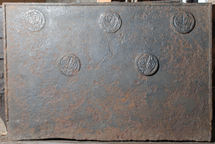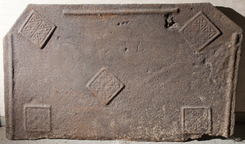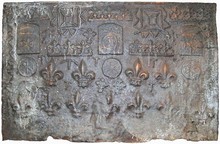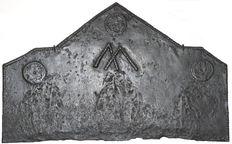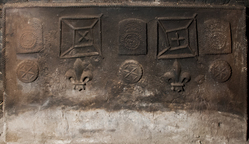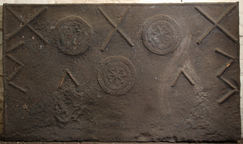-
662
Description: Rectangular; fillet edging (top and sides, except c.100mm at bottom of each side); arrangement of a circular butter print with fleur de lys design, repeated four times: one in each top corner, and two evenly spaced across the middle of the plate; a single circular butter print stamp with a heart-shaped design in the middle top position.
Notes: The fleur de lys stamp can also be seen on a fireback at Nymans, Handcross (no. 96); one of the Pounsley series of firebacks.
- Decoration tags:
- rectangular (shape)
- fillet (edging)
- simple stamps
- objects
Manufactured: in the mid- to late-16th century possibly at Pounsley Furnace, Framfield in the Weald area of England.
Current location: Hole Park, Rolvenden, Kent, England.
- Attached to series:
- Pounsley series
- Food mould stamp firebacks
-
1089
Description: Canted quasi-rectangular shape with no edging; straight length of ?dowel placed parallel to top and to each side; square stamp with fillet edge and four diagonally quartered squares repeated five times, three rotated with sides 45 degrees to the vertical in top corners and slightly left of lower centre, and two, unrotated, repeated twice in bottom corners.
Notes: The square stamps may be pastry moulds.
- Decoration tags:
- rectangular with canted top corners (shape)
- none (edging)
- simple stamps
- carved stamps
- objects
Manufactured: in the mid- to late-16th century in the Weald area of England.
Current location: Authentic Reclamation, Lymden Lane, Ticehurst, East Sussex, England.
- Attached to series:
- Crossed square Wealden series
- Food mould stamp firebacks
-
713
Description: Rectangular; twisted rope edging (top and sides); top row, two square-within-a-square arrangements of twisted rope between three stamps formed of Gothic tracery cresting; 2nd row, two more tracery cresting stamps between two crowned, star-embossed butter mould stamps with a crowned rose-en-soleil stamp in the middle; 3rd row, three star-embossed butter mould stamps with two pairs of fleurs-de-lys between them; bottom row, seven fleurs-de-lys; plus intersepersed fragments of cresting and short rope lengths, a vertical arrangement of cresting fragments down the right side and a vertical, zig-zag arrangement of rope lengths on the left side.
Notes: The rose-en-soleil was the badge of King Edward IV and, thus, a Yorkist symbol. Many of the stamps employed on this fireback are seen, with other stamps, on a wide variety of firebacks, suggesting a common source; similar gothic tracery cresting can be seen as pierced cresting on a rare late-Medieval, wooden Easter sepulchre at the redundant church of St Michael at Cowthorpe, North Yorkshire. A similar fireback is at Anne of Cleves House, Lewes (no. 371). Christie's auction, 24 May 2001.
Copies of this fireback are known.
- Decoration tags:
- rectangular (shape)
- rope (edging)
- simple stamps
- carved stamps
- heraldic
- objects
Manufactured: in the mid- to late-16th century possibly at Pounsley Furnace, Framfield in the Weald area of England.
Current location: not known.
-
733
Description: Rectangular with canted top corners and a triangular extension from the top edge; twisted rope edges to all sides except bottom; a circular wafering iron or butter mould stamp, incorporating a square design with a fleur-de-lys on each side, repeated thrice, one at the apex and one below each of the canted corners; two inverted ‘V’ rope shapes overlapping to make an ‘M’ below top stamp.
Notes: The inverted double 'V' may be apotropaic, invoking the protection of the Virgin Mary; the circular stamp has also been noted on a Pelham-associated fireback of 1642 (no. 1204) which may suggest that it was a product of one of the family's ironworks.
- Decoration tags:
- rectangular with triangular arch (shape)
- rope (edging)
- simple stamps
- apotropaic
- objects
Manufactured: in the late-16th to early-17th century possibly at Waldron Furnace in the Weald area of England.
Current location: Victoria & Albert Museum, Cromwell Road, Kensington & Chelsea, Greater London, England.
Museum number: 895.1901 (part of the Victoria & Albert Museum museum group)
Citation: Page, S. & Wallace, M. (eds.), 2018, Spellbound (Oxford, Ashmolean Museum), p. 72.
- Attached to series:
- Food mould stamp firebacks
- Rope design firebacks
-
1276
Description: Rectangular shape; twisted rope edging (top and sides only); along the top, two irregular arrangements of rope lengths forming a small quasi-square within a larger quasi-square, with the outer corners of the small square joined to the inner corners of the larger square, a short length of rope extending outwards from the top and bottom right corners of the larger square, and within the left small square a rope saltire, and in the right small square a rope cross; between and outside of these rope arrangements, an arched rectangular stamp, with indented edges, of a crowned rose-en-soleil impressed three times; below each rope pattern a fleur-de-lys; below each rose-en-soleil stamp, a circular, six-pointed-star-embossed stamp with beaded edging.
Notes: All of the stamps have been noted on a series of other firebacks together with variations of the rope arrangement. The clarity of the condition of the stamps suggests that this casting predates the others in the series.
- Decoration tags:
- rectangular (shape)
- rope (edging)
- simple stamps
- carved stamps
- heraldic
- royal
- objects
Manufactured: in the mid- to late-16th century possibly at Pounsley Furnace, Framfield in the Weald area of England.
Current location: in private hands, Wadhurst, East Sussex, England.
- Attached to series:
- Pounsley series
- Rose-en-soleil series
- Food mould stamp firebacks
-
1042
Description: Rectangular; twisted rope edging (top and sides); top centre, twisted rope saltire between two food moulds used as stamps, comprising two concentric discs with a hatched design and enclosing four hearts arranged in a cross; below the saltire another food mould stamp; in the top corners, a twisted rope saltire with a double V design below each, the open ends facing inwards; below each of the upper pair of food mould stamps, an inverted twisted rope V.
Notes: The food mould stamps can be seen on another fireback dated to 1562; the rope Vs and saltires have an apotropaic, or evil averting, purpose.
- Decoration tags:
- rectangular (shape)
- rope (edging)
- simple stamps
- carved stamps
- apotropaic
- objects
Manufactured: in the mid-16th century in the Weald area of England.
Current location: Manor House, North Lane, West Hoathly, West Sussex, England.
Citation: Hughes, G. B., May 1940, 'Old English Firebacks', Apollo, 31, 185, pp. 117-120.
- Attached to series:
- Food mould stamp firebacks
- Heart cross stamp series
-
1204
Description: Arched rectangular shape; ovolo moulded edging; date in arch; below arch two parallel, vertical straps, each with a buckle at the top and six prong holes; initials left and right of centre; in top corners, rectangular framed stamp with inset bird; top centre, to left and right of buckle, circular 'butter mould' stamp with stylised fleur-de-lys design, the left one angled top to left; between each initial and strap, rectangular framed stamp with inset deer with antlers, and star in top left corner; below this, adjacent to each strap end, a circular stamp with symmetrical pattern; to left and right of this, a rectangular stamp with an unidentified animal, possibly a dog..
Notes: The buckles, the date and the initials all appear to be separate stamps but attached to the base board before being impressed to form the mould, as they are identically positioned on all castings. The buckles suggest a connection with the Pelham family; the initials may relate to Sir Thomas Pelham, Bt. (1597-1654) who owned and operated ironworks at Waldron in Sussex. This would appear to be a casting of the original pattern with the addition of five pairs of stamps. The circular stamp with the symmetrical pattern is probably the same stamp that has been noted on an otherwise unrelated fireback (no. 733). Some of the stamps are seen in greater profusion on a fireback formerly at Huggetts Farm, Waldron, Sussex (no. 966) and drawn by Edward Hughes, of Heathfield, in a scrapbook of images compiled by J. Starkie Gardner. Nicholson's auction, Fernhurst, 3 Jul 2021, lot 100 (£5); Bellman's auction, Wisborough Green, 18 Feb 2025, lot 746 (£600).
Inscription: 1642 / T P
- Decoration tags:
- rectangular with round arch (shape)
- ovolo (edging)
- carved stamps
- whole carved pattern
- planklines
- text
- animals
- objects
Manufactured: in 1642 probably at Waldron Furnace in the Weald area of England.
Current location: not known.
- Attached to series:
- 1642 Pelham series
- Food mould stamp firebacks
- Pelham family firebacks
